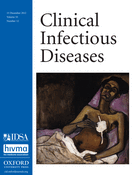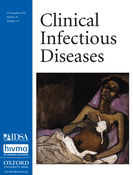
Cover image

On the cover: T.B. Harlem, 1940, by Alice Neel (American, 1900–1984), oil on canvas, National Museum of Women in the Arts, Washington, D.C. Reproduced with permission.
The subject of the painting is a 24-year-old tuberculosis patient, Carlos Negrón, who had come to Spanish Harlem from his native Puerto Rico 2 years earlier. The bandage on his chest covers a wound where surgeons had removed several ribs, as prescribed in accord with the tenents of "collapse therapy," removing the ribs and pushing the chest cavity toward the mediastinum to collapse the lung and hence to emulate naturally healed tuberculosis cavities which were closed, not open. This surgical approach was common from the 1900s to the 1950s.
The patient was the brother of the artist’s lover at the time, the jazz musician José Santiago. Unfortunately for his young brother who had only arrived in New York a short time earlier, tuberculosis was common in depressed, crowded areas such as the Spanish Harlem of the 1940s. As he was within the entourage of the artist Alice Neel, who was a dedicated portrait painter, she recorded his image, tragic though it was.
From her early years at the Philadelphia School of Design for Women, where she trained with George Harding, an Ashcan School follower and illustrator, through her painful, poverty-stricken decades in New York, Alice Neel was obscure and out of step as a social realist during the Abstract Expressionist era. By the 1970s, however, she attained the limelight with her extensive portfolio of portraits and a retrospective at the Whitney Museum of Art; in the last year of her life, she appeared twice on the Johnny Carson show.
(Mary & Michael Grizzard, Cover Art Editors)
Volume 55, Issue 12, 15 December 2012
NEWS
15 December News
IN THE LITERATURE
In the Literature
ARTICLES AND COMMENTARIES
Q Fever: Single-Point Source Outbreak With High Attack Rates and Massive Numbers of Undetected Infections Across an Entire Region
We present an essential prospective case study linking a veterinary outbreak of Q fever on a single dairy-goat farm to a human Q-fever cluster with massive numbers of undetected infections and exceedingly high attack rates across an entire region.
Acquired Resistance to Second-Line Drugs Among Persons With Tuberculosis in the United States
This study provides the first comprehensive assessment of acquired resistance predictors for 2 key classes of second-line antituberculosis drugs that may help identify patients at greater risk for developing extensively drug-resistant tuberculosis.
Association Between Corticosteroids and Infection, Sepsis, and Infectious Death in Pediatric Acute Myeloid Leukemia (AML): Results From the Canadian Infections in AML Research Group
We conducted a retrospective study of infectious outcomes in children with acute myeloid leukemia. Duration of corticosteroid exposure was significantly associated with microbiologically documented sterile site infection, bacteremia, fungal infection, sepsis, and infectious death.
Serological Response to Treatment of Syphilis According to Disease Stage and HIV Status
The serological response to treatment was studied in 264 syphilis patients; it was influenced by syphilis stage but not by human immunodeficiency virus infection and reinfection. Some of the recommendations of current guidelines are critically discussed, and amendments are proposed.
Editorial Commentary: A Syphilis Wish List: Better Data, Better Tests
Hormonal Contraceptive Use and Persistent Staphylococcus aureus Nasal Carriage
Colonized human nares are important for the spread of Staphylococcus aureus infections. The common use of hormonal contraception seems to substantially increase this reservoir, with potential impact on S. aureus infections and transmission.
Nosocomial Infections in Adult Cardiogenic Shock Patients Supported by Venoarterial Extracorporeal Membrane Oxygenation
Patients who received the latest generation venoarterial extracorporeal membrane oxygenation (ECMO) for refractory cardiogenic shock still had a high risk of developing nosocomial infections, particularly ventilator-associated pneumonia. Rates of nosocomial infections increased with longer ECMO support, and infection severity was independently associated with in–intensive care unit death.
Rapid Effectiveness of Minocycline or Doxycycline Against Macrolide-Resistant Mycoplasma pneumoniae Infection in a 2011 Outbreak Among Japanese Children
An outbreak of Mycoplasma pneumoniae pneumonia occurred among children throughout Japan in 2011. Eighty-seven percent of isolates were macrolide resistant. Minocycline and doxycycline were significantly more effective clinically in reducing bacterial DNA in samples than tosufloxacin.
Editorial Commentary: Infections Due to Macrolide-Resistant Mycoplasma pneumoniae: Now What?
Patient Attitudes Toward the Use of Fecal Microbiota Transplantation in the Treatment of Recurrent Clostridium difficile Infection
Despite a widely held belief that the aesthetics of fecal microbiota transplantation (FMT) would limit its use in clinical practice, it appears that patients are open to FMT as an alternative treatment in the setting of recurrent Clostridium difficile infection.
Editorial Commentary: Fecal Microbiota Transplantation: Patient and Physician Attitudes
Clostridium difficile Ribotype Does Not Predict Severe Infection
The association between hypervirulent ribotype and severe Clostridium difficile infection was nonsignificant after adjustment for microbiologic, epidemiologic, and laboratory variables. This nonsignificant association was further validated using an independent data set.
Editorial Commentary: 027, 078, and Others: Going Beyond the Numbers (and Away From the Hypervirulence)
BRIEF REPORT
Acute Otitis Media Replacement and Recurrence in the Finnish Otitis Media Vaccine Trial
PHOTO QUIZ
Ten-Year-Old With Fever, Headache, and Neck Stiffness
INVITED ARTICLE
IMMUNOCOMPROMISED HOSTS
State-of-the-Art Monitoring of Cytomegalovirus-Specific Cell-Mediated Immunity After Organ Transplant: A Primer for the Clinician
Cellular assays to detect cell-mediated immunity to cytomegalovirus are under development and may be useful tools for refining prevention and treatment in organ transplant patients. We review the utility and potential clinical applications of these assays.
HIV/AIDS
The Effect of a “Universal Antiretroviral Therapy” Recommendation on HIV RNA Levels Among HIV-Infected Patients Entering Care With a CD4 Count Greater Than 500/µL in a Public Health Setting
A recommendation by San Francisco General Hospital in January 2010 to initiate antiretroviral therapy in all human immunodeficiency virus (HIV)–infected patients led to a rapid increase in HIV RNA suppression among patients with a CD4 cell count of >500 cells/μL after clinic enrollment.
Effect of Antiretroviral Therapy on the Diagnostic Accuracy of Symptom Screening for Intensified Tuberculosis Case Finding in a South African HIV Clinic
Diagnostic accuracy of symptom screening to rule out tuberculosis among human immunodeficiency virus–infected individuals undergoing screening prior to isoniazid preventive therapy was evaluated. Symptom screening had poor sensitivity, especially among those on antiretroviral therapy. Without culture-based screening, the risk of inadvertently prescribing isoniazid monotherapy is high.
Mortality in the Year Following Antiretroviral Therapy Initiation in HIV-Infected Adults and Children in Uganda and Zimbabwe
In low-income countries, children ≥4 years and adults with low CD4 count have equally high mortality risk in the 3 months after initiation of antiretroviral therapy, similar to that of untreated individuals. Bacterial infections play a major role; targeted interventions could have important benefits.
Response to Pegylated Interferon Plus Ribavirin Among HIV/Hepatitis C Virus–Coinfected Patients With Compensated Liver Cirrhosis
The efficacy of pegylated interferon plus ribavirin in human immunodeficiency virus/hepatitis C virus (HCV)–coinfected patients with compensated cirrhosis is lower than in those without cirrhosis, although this antiviral combination still leads to a substantial rate of sustained virologic response in those carrying HCV genotype 3.
Vitamin D Deficiency and Its Association With Low Bone Mineral Density, HIV-Related Factors, Hospitalization, and Death in a Predominantly Black HIV-Infected Cohort
Despite a high prevalence of vitamin D deficiency (VDD) among a predominantly black human immunodeficiency virus (HIV)–infected cohort, deficiency did not explain an observed racial disparity in low bone mineral density. Prevalence of VDD among HIV-infected persons was not significantly different from non-HIV infected controls.



